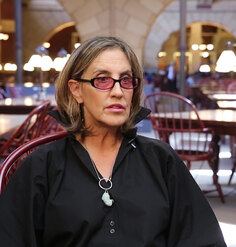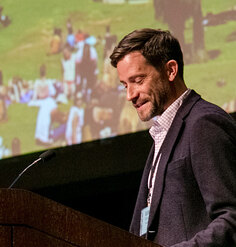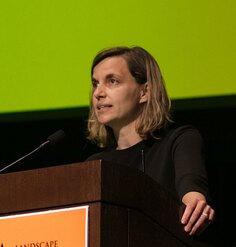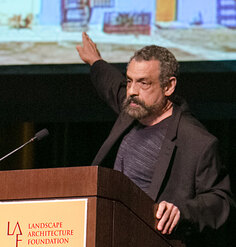Landscape Architecture: New Adventures Ahead!
By Dirk Sijmons
This presentation was part of the Landscape Architecture Foundation’s The New Landscape Declaration: A Summit on Landscape Architecture and the Future held in Philadelphia on June 10-11, 2016. LAF asked a diverse group of leading minds to write a “Declaration” reflecting on the last half century and offering bold ideas for how landscape architecture can make its vital contribution in response to the challenges of our time.
Dirk Sijmons
Cofounder, H+N+S Architects
Delft, Netherlands
Dirk Sijmons is a landscape architect and in 1990 cofounded H+N+S Landscape Architects. He studied architecture and environmental planning at the Technical University of Delft, where, since 2008, he has been professor of environmental design. Sijmons was curator of the International Architecture Biennale Rotterdam (IABR—2014) with the theme Urban By Nature .
* Affiliation at the time of the Summit
Landscape Architecture: New Adventures Ahead
by Dirk Sijmons
From my European perspective, the last 50 years have been marked by the growth and emancipation of our discipline. Landscape architecture has been freed from being the broccoli around the steak to becoming a discipline with its own agenda. The profession broadened its working field and its scope in that half century. It diversified. The traditional core of the discipline—making gardens and parks—expanded into public space design and the new field of retrofitting derelict industrial areas. The most talked about parks, like Parc de la Villette, Duisburg-Nord, and the High Line, are all brownfield parks. These parks have been pivotal in urban renewal processes and spurred real estate development.
For the discipline itself, however, the most important innovations were likely new ways of representing nature. For most of the modernist period, nature was reduced to a backdrop for leisure programs, but in recent parks representing nature has made a comeback. The formal architectonic representation in Parc de la Villette, the free range for spontaneous urban nature in Duisburg-Nord (where time itself seems to have become the main park theme), and the staged wild nature represented by configurations of Piet Oudolf’s perennials on the High Line inspired by the self-seeded landscape that grew up between rail tracks—all show a distinct, more architectonic idiom being developed, even completed, by the "starchitects" of the profession.
Among the more anonymous professionals at the other end of the disciplinary spectrum, the expansion was almost as impressive. The traditional role of designing the landscape of infrastructure and agricultural development was steadily built upon to include designing new forests, water infrastructure, nature development, leisure projects, glass warehouse districts, airfields—in short, all the agents of change identifiable in the landscape that can be invited to make an expressive contribution to the landscape. In this century, urbanization itself was identified and addressed as a landscape architectural issue. Thomas Sieverts laid the analytical basis in his Zwischenstadt (Vieweg Braunschweig 1997) and that basis was instrumentalized by Charles Waldheim in Landscape as Urbanism: A General Theory (Princeton University Press 2016).
The 2014 International Architecture Biennale Rotterdam (IABR-2014) Urban by Nature took stock of the consequences. It positioned the viral growth of urban landscapes, especially the urban carpets in the large deltas of the world, in the wider context of the Anthropocene, the age of mankind.
The concept of the Anthropocene (Crutzen, 2000) produces some interesting side effects for our discipline. The once strict boundary between nature and human society is crumbling. Human interventions can be seen as, and compared with, forces of nature. We become aware that anthropogenic processes do not just influence geochemical cycles, biodiversity, sediment flows, ocean acidity, land use, sea use, and the climate, but that all these processes produce hybrids.
Anthropocene suggests that human and natural processes are linked in a complex whole. There is no initial situation or natural equilibrium to fall back on, just as we cannot go back to last week’s weather. We can only go forward, and we must find the best ways of making progress and learning to ride this tiger.
The urban landscape is one of the largest of these hybrids. This artifact, formally known as the city, is our habitat. Most of the world’s environmental problems have their roots in the urban landscape. To solve the current environmental crisis, we must retrofit our urban landscapes by patiently reweaving the extensive urban carpets into more sustainable configurations. We must improve the poorly functioning metabolism of these urban regions. This will involve projects focused on urban microclimate, sweet water supply, energy (transition), urban biogeography, disaster resilience, defragmenting the ecology, changing flows of sediments, and building material.
If we want to propel LAF’s 1966 Declaration of Concern another half century into the future and claim that our discipline is pivotal to solving these environmental problems, urban landscapes must be both the subject and the backdrop of our work. Landscape architecture is well positioned for the task.
First, we might be one of the few disciplines able to create a link between construction science and the life sciences. In this context, cultural representation of nature changes into mediating between nature and society. To my mind, without this vital mediation, we will find no lasting solutions for the problems of urban landscapes. Without it, the toolbox of the engineers and urbanists will be limited to half-baked technical solutions.
Furthermore, landscape architecture has a good track record in research-through-design with problems at the regional scale and at a landscape scale. In these (future) research trajectories, we learn to work in transdisciplinary teams where we will blossom as synthesizers, as generalists with a specific skill: (spatial) design. In addition to the natural sciences and the humanities, design is a third and separate domain of knowledge in which research uses modeling, pattern recognition, and synthesis. An appealing and unique element of research-through-design is that it can elegantly include the concept of free will. It concerns a future that is neither completely determined nor entirely unpredictable, but rather one that has, to some extent, a malleable character. Questions like “what can we want?” come with that territory. These plans have a new public. They are not aimed directly at execution but at influencing public opinion. Design can mediate between politics, other actors, and citizens. Design could even be instrumental to the design of the political will.
This type of work will require a stronger focus on understanding natural and social processes and design using their relationship with the spatial. Sometimes the scale will be geographic and raise questions: Is this still landscape architecture? Will landscape architecture preserve its disciplinary coherence with this broad scope and at these high levels of scale? Will the absence of real clients in these research-through-design trajectories loosen the ties with the programmatic precision? Is the connection with the genius of the place lost in a focus on processes? Or is the cultural element so homeopathically diluted that the lifeline to aesthetics, or even the discipline itself, snaps?
The overarching characteristic of all these scales and working fields is that specific link between program, place, and process. If this triad is present, we can still call it landscape architecture. A link with the spatial could function as a litmus test. Thus, projects in geoengineering or the acidity of the oceans would fail such a test.
But maybe we just need to stop worrying about these questions and restrict ourselves to the open-ended conclusion the landscape architecture is what landscape architects do.











